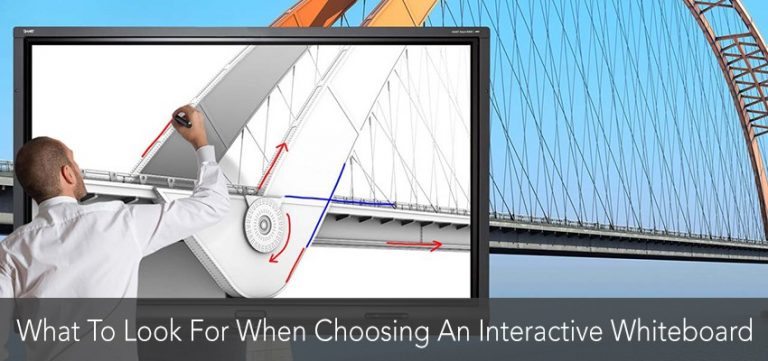What To Look For When Choosing An Interactive Whiteboard
Interactive whiteboards have become increasingly popular over the last few years, and the technology behind these tools continues to evolve. For some who may be unfamiliar with interactive whiteboards, they come in several flavours. They can be a large whiteboard that is connected to a computer and a projector. The projector casts the computer’s desktop on to the display where the user can then control the computer using a pen, finger, stylus, or other specialized writing device. In other cases the whiteboard technology is built into a flat panel display, generally up to 70 or 80 inches. Users interact directly on the screen with touch or a stylus. Finally, it is possible to outfit an existing display with an overlay device that enables the whiteboard functionality.
There are several important aspects to consider when implementing an interactive whiteboard system in to your boardroom or classroom.
Size & Shape Of The Screen
The size of the whiteboard is one of the most important specifications to look in to when evaluating different options. The size of room and the size of the whiteboard are important for determining how it will be used in the classroom or boardroom. You should ensure that you get a whiteboard large enough for people in the back of the room to be able to see easily. For example, a smaller board will not work well in a larger conference room, especially if it will be used for text heavy documents.
With regards to aspect ratio, or “shape” of the whiteboard, most choose between 4:3 and 16:9 aspect ratio. 16:9 is a wide screen aspect and is becoming increasingly more popular because of laptop screens and projectors having screens of this aspect ratio becoming more common. Some also feel the 16:9 is more similar seeming to a traditional whiteboard.
Software Package
Another very important consideration when choosing an interactive whiteboard is what software comes with it. Many options include some sort of software application and depending on how the board will be used, it is important to pay attention to what this software can do to ensure that it will meet your needs. Some software applications will have more features and tools, so looking in to the ease of use of these tools is another important consideration. You also need to make sure that the whiteboard any software that comes along with it is compatible with your computers operating system.
Active Screen Area
When looking at different interactive whiteboard options it is important to understand pay attention to the active screen areas vs. inactive screen areas. The active areas is the part of the screen that can be used as touch screen and for other interactions. This can dramatically vary on different types of interactive whiteboards. For example, some are able to fill the entire screen with the desktop image, whereas others will limit the area that is able to be active.
Cabling and Connections
It is important to look in to what kind of connections and power requirements that your whiteboard will need. You also want to check how the whiteboard is powered and what accessories can be used with it. This often includes needing a computer that can be hooked up to it and an internet connection. Determine what cables are necessary for powering the board, connecting the computer, connecting it to the internet and any other connections necessary. Some interactive whiteboards have Bluetooth connectivity, which can drastically reduce the number of cables that are necessary.
Type Of Technology
Different interactive whiteboards use different technology in order to be used as touch screen. This can often be up to personal preference but it is important to understand the differences between these different types of technology in order to understand how it affects how the whiteboard will be used.
The two types of technology used are often resistive and electromagnetic technology. Resistive uses an interactive whiteboard with a plastic front sheet and hard backboard. The front of backboard and the back of plastic sheet are covered with layer of resistive film, with the film separated by an air gap. When pressure is applied to the front sheet, it closes the air gap and registers a point of contact and it responds accordingly. This can be done with finger or a stylus. Electromagnetic technology relies a lot more on the tool used to write on the board. The pen tool contains a transponder that gives out an electronic signal and the signal tells the computer the coordinates of the pen or stylus. Since this relies on the transmit signal, you are not able to use your finger to control the board.
Interactive whiteboards have potential to be a great tool in both boardrooms and classrooms. They give the ability to share information, concepts and brainstorm ideas by taking collaboration to the next level. They can increase engagement, accommodate different learning styles, and help provide intuitive interactions. Similarly, most interactive whiteboards can also fully integrate in your current audio-visual environment.



